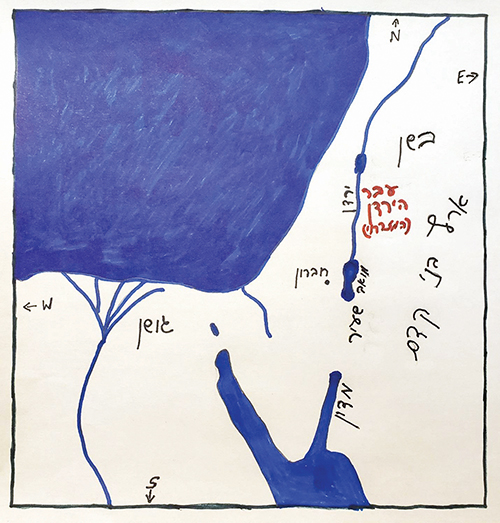
When Yaakov was brought to חברון to be buried, they stopped at גרן האטד, which is described as being בעבר הירדן (Bereishis 50:10). However, to get to חברון from Egypt, there’s no need to cross the ירדן. As a matter of fact, since חברון is west of the Dead Sea, and the ירדן empties into it, in order to get to the other side of the ירדן from Egypt one must either pass near חברון before crossing the ירדן, or travel well south of חברון, continuing east past the southern end of the Dead Sea and then north past its northern end. Why did they go so far out of the way?
Chizkuni suggests that the “dwellers of the land, the Canaani” (50:11) refers to Sichon and Og, whose land was on the east side of the ירדן. From their perspective, “עבר הירדן” was the west side of the ירדן, not the east side. [Even though חברון is parallel to the middle of the Dead Sea, and therefore south of where the ירדן ends, since Sichon and Og are north of the Dead Sea, to get to חברון they would cross the ירדן.] However, this only addresses the second reference to גרן האטד being בעבר הירדן (in 50:11). Until these “dwellers” were referenced, how could it be described as being בעבר הירדן? Besides, why mention that it’s בעבר הירדן at all if it refers to the same side the mourners were on the entire time? (If the point was to teach us which “dwellers” are being referred to, they should be the ones who were בעבר הירדן, not גרן האטד!)
The Talmud (Bechoros 55a) says that after the ירדן reaches the Dead Sea, it continues to the Mediterranean. Since this would be from east to west, in order to get from Egypt to חברון one would have to cross this part of the ירדן from south to north. If גרן האטד is north of this part of the ירדן, it would be “the other side” from Egypt’s perspective. (If it was south of it, it would be “the other side” from Canaan’s perspective.) The obvious issue with this approach is that the ירדן doesn’t continue past the Dead Sea (see ArtScroll’s footnote #41 and the notes in the back of the Mesivta). And describing גרן האטד as being בעבר הירדן isn’t really helpful, since we don’t know whose perspective it’s coming from.
In Places in the Parasha, Yoel Elitzur quotes the approach of his father (Yehuda Elitzur, z”l, co-author of Atlas Daat Mikra), which has two elements to it. First he points out that when the expression עבר הירדן is used in Tanach, it usually includes which side of the Jordan River is being referred to (east or west). He suggests (bringing supporting evidence) that when we aren’t told which side is under discussion, the expression refers to the Jordan Rift Valley, i.e. “the side of the Jordan,” as opposed to “the other side of the Jordan.” (Bear in mind that the word “עבר ” means “side.”) It could be either side, as long as it’s right next to it (in the Jordan Rift Valley). In this case, it would be the west side, since there was no need to cross the Jordan.
This isn’t enough to resolve our difficulty, though, since the Jordan Rift Valley adjacent to the ירדן is northeast of חברון, and is therefore still out of the way. So he adds a military element.
At that time, Egypt controlled Canaan, and had military outposts there. It was time to rotate the troops stationed at these outposts, so the Egyptian military accompanied Yosef and his family to Canaan (see 50:9), with גרן האטד being near an outpost in the Jordan Rift Valley. The troops stayed there, while the family continued to (חברון (50:12-13). However, why would Yaakov’s family go out of the way and follow the troops past חברון to their outpost? Additionally, we are told explicitly (50:14) that it wasn’t only the family who returned from חברון to Egypt.
In 5773, I also incorporated a military angle to explain why this entourage of mourners went all the way around the Dead Sea and then north before crossing the Jordan (from east to west) to get to חברון, adding another element as well. Yosef knew that if he went straight to חברון with the chariots and horsemen that were being sent to accompany his father, it would be perceived as a military attack. He also wanted to give his extended family – those related through Eisav, Yishmael, Keturah and Lot – an opportunity to mourn for Yaakov without having to travel all the way to חברון. So instead of going straight to חברון, he went to the east side of the Jordan, passing Eisav’s home (southeast of the Dead Sea), to the area where Lot’s children (Ammon and Moav) had settled, near where the descendants of Yishmael and Keturah lived. As suspected, thinking this was an invading Egyptian army, these nations (as well as Canaan) joined together to attack the entourage. But when they saw Yaakov’s coffin, and realized it was a funeral procession rather than a military maneuver, they joined in the mourning (see Rashi on 50:10).
It’s certainly possible that some of the Egyptian troops remained in Canaan, while those they replaced continued with everyone else to חברון and then back to Egypt. It’s also possible that גרן האטד is in the Jordan Rift Valley (and why it’s “בעבר הירדן”). But in order to include the extended family in the mourning, it makes sense for Yosef to have followed the same route that the nation would eventually take after the Exodus – south of the Dead Sea then north to the other side of the Jordan – to get to the Promised Land.
Rabbi Dov Kramer wrote a weekly dvar Torah from 5764-5776; the piece he wrote in 5773 can be accessed at RabbiDMK.wordpress.com/2012/12/27/parashas-vayechi-5773.












